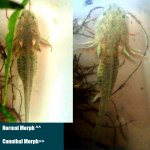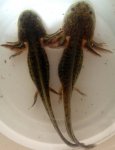SludgeMunkey
New member
I was reading through my old axolotl files last night and stumbled across a few pages I had printed out about how the jaw and tooth morphology of axolotls that were allowed to cannibalize siblings were different than those that did not cannibalize siblings as neonates. A few of the pages are missing, and I cannot find the source anymore.
Then after way too many cups of coffee at work I got got to wondering about this. I was hoping someone more knowledgeable could offer insights of links to references I could read on this subject.
So, here's what I was wondering about:
1. Is this true, or is this a bit of misunderstanding on my part?
2. Is this true only in Ambystoma mexicanum, or prevalent through all Ambystomids? Does it happen with other types of newt or salamander?
3. Is this a result of some science fiction like protien assimilation, or digestion of hormones from the devoured siblings, or some other reason I have absolutely no way of imagining?
4.Where would be a good source to find scientific documentation on this subject nowadays? These pages are from circa 2001-3
Then after way too many cups of coffee at work I got got to wondering about this. I was hoping someone more knowledgeable could offer insights of links to references I could read on this subject.
So, here's what I was wondering about:
1. Is this true, or is this a bit of misunderstanding on my part?
2. Is this true only in Ambystoma mexicanum, or prevalent through all Ambystomids? Does it happen with other types of newt or salamander?
3. Is this a result of some science fiction like protien assimilation, or digestion of hormones from the devoured siblings, or some other reason I have absolutely no way of imagining?
4.Where would be a good source to find scientific documentation on this subject nowadays? These pages are from circa 2001-3
Last edited:


